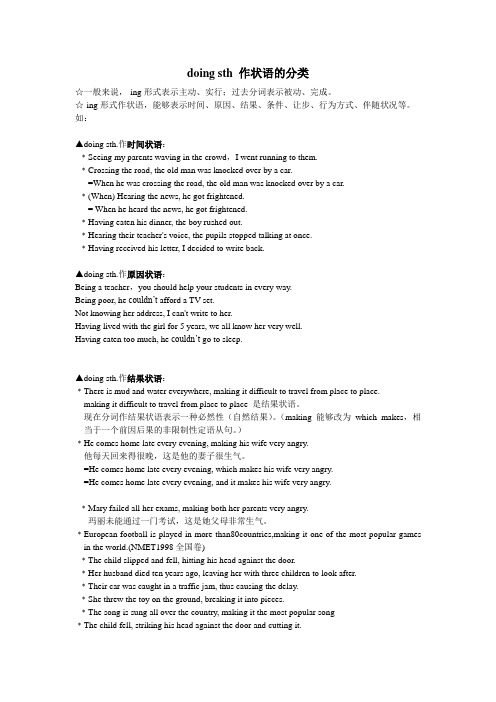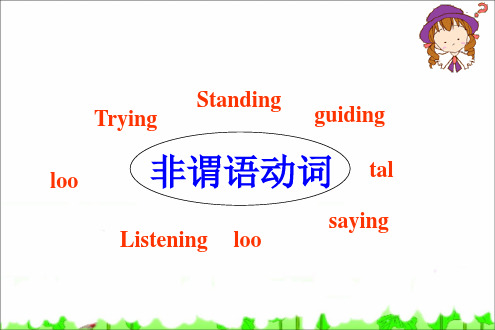(完整版)doing作状语.ppt
状语从句(完整版)ppt课件

状语从句(完整版)ppt 课件
REPORTING
目录
• 状语从句概述 • 时间状语从句 • 地点状语从句 • 原因状语从句 • 条件状语从句 • 目的状语从句 • 让步状语从句 • 结果状语从句
PART 01
状语从句概述
定义与作用
定义
状语从句是句子中充当状语成分的从 句,用于修饰主句中的动词、形容词、 副词或整个句子,表示时间、地点、 原因、条件、方式、让步等关系。
When I grow up, I want to be a teacher. (当我长大的时候,我想成 为一名老师。)
I was doing my homework when the phone rang. (电话响的 时候,我正在做作业。)
Once you start, you must finish it. (一旦你开始,就必须完成它。)
你想去的地方。
They searched for the lost child everywhere. 他们到处
寻找那个走失的孩子。
PART 04
原因状语从句
表示原因的连词
because
语气最强,表示直接的原因或理 由,可用于回答 why 提出的问 题、引导表语从句、用于强调句
等。
since
语气比 because 弱,但比 as 强, 一般用于表示“由于大家已知的 事实”。
虚拟语气
在条件状语从句中,可以 使用虚拟语气来表达与现 在或过去事实相反的情况。
条件状语从句的例句分析
01
02
03
04
05
If you study hard, you will pass the exam. (如 果你努力学习,你会通 过考试的。)
doing作定语市公开课一等奖省赛课微课金奖PPT课件

• 3. The man knocked at the door must be
our uncle.
knocking
• 4. With the boy led the way, we found the
village easily.
leading
10/21
V-ing形式作状语基本使用方法
• v-ing作状语时,能够表示时间、原因、结 果、条件、让步、伴随动作等。除作伴随 状语外,其它状语相当于与之相对应状语 从句,而作伴随状语时,可转换为并列句。 但要注意它各种形式改变:
∧
which is
9/21
即时训练
• 单句改错: going
• 1. I couldn’t do my homework with all that noise went on. smelling
• 2. The flowers smelt sweet in the botanic garden attract the visitors to the beauty of nature.
• 3. Exercises • 4. Homework
2/21
Step1—Revision
• 例句观察: • 1. Reading books widens our knowledge. • 2. He enjoys fishing. • 3. His acting is so amusing that all of us can’t
laughing all the time. • 4. What an interesting joke it is! • 5. We found the dog lying near the river, dead. • 结论:
非谓语动词之分词作状语(公开课课件)PPT课件

分词短语作时间状语
表示分词的动作与句子主语的动作在 时间上有先后关系,如“Having finished his work, he went home.”
04
分词作状语的注意事项
分词作状语与从句的区别
分词作状语通常表示伴随、时 间、条件等关系,而从句则可 以表达更复杂的关系和意义。
分词作状语不具有主语和谓语, 而从句有主语和谓语。
详细描述
分词作状语通常紧跟在主语之后 ,表示主语执行的动作或状态的 方式、时间、条件、原因等,是 对主语动作或状态的补充说明。
分词作状语的种类
总结词
分词作状语可以分为现在分词作状语和过去分词作状语两种 。
详细描述
现在分词表示主语正在进行的动作或存在的状态,而过去分 词则表示主语已经完成的动作或存在的状态。
非谓语动词的用法
用作主语
例如,To learn English is important.(学习英 语很重要。)
用作宾语
例如,I like reading books.(我 喜欢读书。)
用作表语
例如,The problem is to find a solution.(问题在于 找到一个解决方案。)
分词作状语的特殊用法
分词短语作伴随状语
分词短语作条件状语
表示分词的动作与句子主语的动作同 时发生,如“He left, accompanied by his secretary.”
表示分词的动作与句子主语的动作在 条件上有因果关系,如“Given more time, they could have done better.”
练习一
请将下列句子中的分词转换为适 当的状语从句。
句子
Hearing the news, she jumped with joy.
高中英语非谓语动词做状语(共77张PPT)

society.
原因状语
不
定
表目的
式
作
表原因
状
语
表结果
2) 不定式做状语
形式
意义
To do
主动,将来
Байду номын сангаасTo be done
被动, 将来
To be doing
主动, 正在
To have done
主动,完成
To have been done 被动,完成
表目的
I study hard _t_o_s_e_r_v_e__ the people well. To serve the people well, I study hard. (置于句首加强语气)
3. Having been separated from other continents for millions of years,Australia has many plants and animals not found in any other countries in the world.
do
结we果ll状in语your
伴( 随状语 )
4.his parents died in the war, leaving him
an orphan
目的(状语
)
一 非谓语动词做状语的形式: doing/ having done done/being done/having been done to do/ to be done
被动,先于谓语动词发生
2) 不定式做状语
形式
意义
To do
主动,将来
To be done
被动, 将来
To be doing
高考英语非谓语动词作状语(共22张PPT)

2. She got off the bus, but __le_f_t __ (leave) her handbag on her seat.
11
二判断逻辑主语
Step1 Lead—in
Seeing from the hill, you will
find the valley looks very beautiful.
1
Seen from the hill, the valley looks
like a big garden.
2
A big earthquake happened in Jiuzhai
__Oh, noB._e_i_n_g__re__p_a_ir_e_d__④__,(repaire) the right side of t
he road is closed for the time being.
8
6.We hurried to the station, only _to__f_in_d_②(find) the
verbs used as adverbial
b. The students know the difference between the
present participle and the past participle.
.2. objectives of processes and methods:
feeling tired.
3.F_o_u_n__d_e_d_⑩(found) in the early 20th century, the school
动词-ing形式作宾补和状语

8. I left children ____(watch) television.
9. The policeman caught two boys ____(fight) in the street. 10. With the exam ____(draw)near, we all felt anxious. keys:1. lying 2. grow 3. rising 4. hoping 5. adding 6. Not having received 7. Having suffered 8. watching 9. fighting 10. drawing
(2)I often hear him sing this song.我经常 听到他唱这首歌。
注:①see sb./sth. doing变成被动语态,其 结构是sb./sth. be seen doing,doing在这里成 了主语补足语。 The missing boy were last seen playing near the river。那个失踪的男孩最后一次被看到是 在河边玩耍。
Working in the factory, she made a lot of factory. 在工厂工作期间,她交了很多朋 友。
Being ill, the boy didn’t come to school.因为 病了,那个男孩没有来学校。
Working hard, you will succeed.努力学习, 你就会成功。
Not knowing his telephone number, we couldn' t get in touch with him. 由于不知道 他的电话号码,我们没法与他联系。
doing作状语

doing作状语1.用法:动词ing作状语时,可以表示时间、原因、结果、条件、方式或伴随动作。
通常可转化成与之相对应的状语从句。
2.分类:(1)作时间状语e.g. Walking in the park, she saw an old friend.= When/While (she was) walking in the park, she saw an old friend.Having finished the work, he went to see his teacher.= After he had finished the work, he went to see his teacher.(2)作原因状语e.g. Being too young, he couldn't join the army.= As he was too young, he couldn't join the army.Not knowing how to get there, I had to ask the way.= As I did not know how to get there, I had to ask the way.(3)作条件状语e.g. Working hard, you'll make great progress.= If you work hard, you'll make great progress.(4)作结果状语e.g. His parents died, leaving him an orphan.= His parents died and left him an orphan.The snow lasted a week, resulting in a serious traffic confusion in the whole area.=The snow lasted a week, and resulted in a serious trafficconfusion in the whole area.注意:动词ing形式与不定式均可作结果状语,区别是:动词ing 形式表示顺其自然、意料之中的结果,而不定式则表示不愿看到的、出人意料的结果。
doing sth 作状语的分类

doing sth 作状语的分类☆一般来说,-ing形式表示主动、实行;过去分词表示被动、完成。
☆-ing形式作状语,能够表示时间、原因、结果、条件、让步、行为方式、伴随状况等。
如:▲doing sth.作时间状语:﹡Seeing my parents waving in the crowd,I went running to them.﹡Crossing the road, the old man was knocked over by a car.=When he was crossing the road, the old man was knocked over by a car.﹡(When) Hearing the news, he got frightened.= When he heard the news, he got frightened.﹡Having eaten his dinner, the boy rushed out.﹡Hearing their teacher's voice, the pupils stopped talking at once.﹡Having received his letter, I decided to write back.▲doing sth.作原因状语:Being a teacher,you should help your students in every way.Being poor, he couldn’t afford a TV set.Not knowing her address, I can't write to her.Having lived with the girl for 5 years, we all know her very well.Having eaten too much, he couldn’t go to sleep.▲doing sth.作结果状语:﹡There is mud and water everywhere, making it difficult to travel from place to place.making it difficult to travel from place to place 是结果状语。
doing-做状语-公开课

________ that he was in great danger, Eric walked deeper into the forest.
A.Not realized
我们最大的光荣不是永不摔倒,而是 每次摔倒后我们都能站起来。
English Proverbs (谚语)
No furniture is so charming as books.
什么家具也不如书籍可爱。
English Proverbs (谚语)
A blind man will not thank you for a looking glass.
countries, ______ it the most
popular sport in the world.
A. making
B. makes
C. made
D. to make
解题关键: making it the …=and makes it the…
在句中充当结果状语
Finding her car stolen, ________________. A. a policeman was asked to help B. the area was searched thoroughly C. it was looked for everywhere D. she hurried to a policeman for help
health. Although living far away from school, he was
never late for school. They stood there for half an hour watching the
Unit 2 现在分词作宾补和状语 课件 高一下学期英语人教版(2019)必修第三册

➢Turning to the right, you will find a path leading to his cottage.
4. 表伴随动作(多置于句尾) sit/stand/lie/stay… doing sth. ➢And even as she lay dying, her final
thoughts were for others. ➢Nora stood at the bus stop, waiting for a
bus. ➢Although she was tired, she stayed up
➢ Leave the rice to cook for 20 minutes.
➢ I’ll leave you to decide it.
(5) set sb./sth. doing sth. 开始引起某人/物在做某事
➢His words set me thinking deeply.他的话引起我深思。
(强调动作的全过程结束)
➢ I saw an old man crossing the street. 我当时看见一位老人正在过马路。 (只看见动作片段)
➢ I saw an old man cross the street. 我当时看见一位老人过了马路。 (看见动作的全过程)
➢ — Did you hear the door bell _r_in_g_i_n_g_ (ring)? 门铃在响你听见了吗? —Yes, I did. I heard it __r_in_g_____ (ring) three times. 是的,我听见它响了三下。
➢ I can’t get the car to start. 我不能让车发动起来。
doing作状语

条件状语从句与doing的转换
要点一
如果条件状语从句中主语与主句 主语一致,且含有情态动词或…
“If you come early, you will see him.” 可转换为 “Coming early, you will see him.”
表示导致结果的原因
动词-ing形式还可以表示导致某种结果的原因,强调动作与 结果之间的因果关系。
表示条件
相当于if引导的条件状语从句
动词-ing形式可以表示条件,相当于if引导的条件状语从句的简化形式。
表示假设条件
动词-ing形式也可以表示假设条件,即某个动作或状态如果发生或存在,将会 导致什么样的结果。
Although raining heavily, they still went out.(尽管雨下得很大,他们还是出去了。 )
过去分词作状语
表示时间
Once seen, it can never be forgotten.(一旦看到,就永远不会忘 记。)
表示条件
Given more time, we could have done it better.(如果给我们更 多的时间,我们可以做得更好。)
02
动词-ing形式作状语
表示时间
与谓语动词同时发生
动词-ing形式可以表示与谓语动词同 时发生的动作或状态,相当于一个时 间状语从句。
发生在谓语动词之前
动词-ing形式也可以表示发生在谓语 动词之前的动作,相当于一个时间状 语从句的简化形式。
高中英语——动词ing的用法(共24张PPT)

作定语
⑴动名词作定语表示性质或用途。 a washing machine = a machine for washing a swimming pool = a pool for swimming
This is a new washing machine.
≠Interesting was the story he told us.
作宾语
1.只接动名词的动词:
避免错过少延期 avoid/ miss/ delay/ postpone 建议完成多练习 suggest/advise/finish/complete/ practice
喜欢想象禁不住 enjoy/ imagine/ can’t help 承认否定与嫉妒 admit/ deny/ envy 逃避冒险莫宽恕 escape/ risk/ forgive/ excuse 忍受保持不介意 stand/ keep/ mind 允许感激和考虑 allow/ permit/ appreciate/ consider 明白鼓励要禁止 understand/ encourage/ forbid
•China is a developing country.
作状语
现在分词作状语。表时间、原因、条件、结果、伴随(方 式)等,具有主动和进行的含义。表示其动作与句子的谓 语是同时的。
Hearing the cry for help, he rushed out.(时间)
Being ill, he went home. (原因)
I heard the girl singing in the classroom.
I noticed a long queue outside the bank waiting for it to open.
分词作状语课件 -2023届高考英语一轮复习

怎样区别现在分词与过去分词作状语
1现在分词的一般式doing,现在分词的一般式所表示的动作与句中谓语动词同时发生。Seeing the cat, the mouse ran off.一看到猫,老鼠就跑了。
2 现在分词的完成式 having done现在分词的完成式所表示的动作先于句中谓语动词发生。The storm left, having caused a lot of damage to this area.暴风雨离开了,给这个地区造成诸多破坏。
5 现在分词的否定式在其前面加notNot having completed the programme, they have to stay there for another two weeks. 由于没有完成计划,他们不得不在那里再呆两个星期。
6现在分词作状语的基本用法1)表示时间Walking along the street, I met Mary. (=While I was walking along the street,…) 在街上散步的时候,我遇见了玛丽。
B
6.After seeing the (frighten) film, the boy was too frightened to walk home alone in the dark. 答案 frightening
6现在分词作状语的基本用法6)表示结果:现在分词表示自然而然的结果Their car was caught in a traffic jam, thus causing a delay.他们的汽车遇上了交通堵塞, 因而耽搁了。thus 副词,修饰causing。
7 现在分词作状语表示分词动作的执行者(逻辑主语)就是句子的主语,有时候这类结构可以看作状语从句的省略。When crossing the street,do be careful.过马路时,务必要小心。As long as going into the reading room, you should keep quiet.只要进入阅览室,你就应该保持安静。
Unit 2 动词ing形式作宾语补足语和状语课件-高中英语人教版(2019)必修第三册

(3)The fire lasted nearly a month, leaving (leave) nothing valuable.
(4) Living (live) miles away, he attended the lecture.
11.Having waited(wait) in the queue for half an hour, Joey realized that he had left his wallet at home.
12.Newlybuilt wooden cottages line the street, turning (turn) the old town into a dreamland.
(3) Having lived(live) in Beijing for years, I almost know every place quite well.
(4) Seeing (see) nobody at home, he decided to leave them a note.
2.现在分词的语态
单句语法填空 1.Representing (represent) the Student Association, I went to the airport to meet the international students.
2.Having worked (work) for two days, Steve managed to finish his report.
(2) Having been told (tell) for several times, he still couldn't understand the rules.
高中英语现在分词作状语课件(共26张PPT)

against the ground. (
)
2.动词-ing分词一般式
1. 尽管知道我住在哪里,但他从没来看过我。 _K_n_o_w__in__g__ where I live, he never comes to
see me . Though he knows where I live, he
never comes to see me. 让步状语从句 2. 因为我不知道她的电话号码,所以不能打给 她。 Because I didn’t know her telephone number,
5. _H__a_v_i_n_g__b_e__e_n__t_a_k_e_n___(take) to the lab, we
were taken to the library.
Grammar work: Filling the blanks with –ing form
1. __W__a_lk_i_n_g_s_t_r_a_ig_h_t_____ (一直往前走) , you will
6.从山上看, 我们发现这湖泊更加漂亮了。
If we see from the hill, we find the lake looks more beautiful.
S__e_e_i_n_g_ _f_ro__m_ _t_h_e_h__il_l___, we find that the lake looks more beautiful. -ing分词作条件状语
• Born in Guangzhou, Alice was the only daughter in her family. ‖When she heard the news about Asian Games, she applied to be the first volunteer in her college. ‖ Her parents supported what she had done, and it made her more confident. ‖ Though she was tired , she still did a very good job. ‖ She was considered as the most excellent volunteer, and then Alice was well-known in the college.
doing作状语(共44张PPT)

分词作状语
分词作状语,表示动作发生的条件、原因、结 果、让步、时间、方式或伴随等,通常相当 于一个状语从句或并列分句。 一般说来,这种结构的逻辑主语就是句子的 主语。
作状语时,选择现在分词还是过去分词,关键 看主句的主语。如主语和分词是主谓关系, 就选用现在分词,如分词和主语是动宾关系, 就用过去分词。
动名词作表语用来说明主语的内容,与主语是 同一个概念,表语和主语的位置可互换。
区别动名词与现在分词:
His hobby is painting.
动名词作表语用来说明主语的具体内容。
The news is inspiring.
现在分词作表语是用来表示主语所具有的 特征,有的已变成了形容词,主语和表语的 位置不能互换。
五 V-ing形式作宾语补足语
V-ing形式作宾补时,它与宾语构成逻辑上的主谓 关系,即宾语是其逻辑上的主语。S+V+O+C
I heard the girl singing in the classroom.
We have the fire burning all day. 动词-ing形式作宾语补足语
原因状语 Because he was poor , he couldn’t afford a
TV set. Being poor, he couldn’t afford a TV set.
Because he was satisfied with his job, he had a big smile on his face.
(2) a walking stick = a stick for walking
What’s the difference between
- 1、下载文档前请自行甄别文档内容的完整性,平台不提供额外的编辑、内容补充、找答案等附加服务。
- 2、"仅部分预览"的文档,不可在线预览部分如存在完整性等问题,可反馈申请退款(可完整预览的文档不适用该条件!)。
- 3、如文档侵犯您的权益,请联系客服反馈,我们会尽快为您处理(人工客服工作时间:9:00-18:30)。
最新.课件
12
He looked around and caught a man
_________ his hand into the
pocket of a passenger.
A.put
B. to be putting
C. to put
D. putting
最新.课件
13
Practice:
1. I saw them _f_o_rc_i_n_g(force) the door
4.The bears _d__ri_n_k_i_n_g__c_o_c_a_c__o_la_ make cocacola
more popular.
最ቤተ መጻሕፍቲ ባይዱ.课件
10
五 V-ing形式作宾语补足语
V-ing形式作宾补时,它与宾语构成逻辑上的主谓 关系,即宾语是其逻辑上的主语。S+V+O+C
I heard the girl singing in the classroom.
We have the fire burning all day.
动词-ing形式作宾语补足语 Iwnaoittiin常正cged放在foa在进rliot宾行ntgo语的qo后主puee面动nu.e,性ou表的ts示动id一作e t个,he bank
Twhitehb强garbe调ayt一wina个ttec过rhees程dt.最h或新i.课s一件d种ad状sh态av。ing
his
face
11
1. 能跟-ing形式作宾语补足语的常见 动词有:
make, let, have, keep, leave, look at, see, watch, hear, listen to, notice, find, feel 等。
怎么记? “五让、三看、两听、
一注意、一发现、一 感觉”。简单又好记!
(2) a walking stick = a stick for walking
What’s the difference between
(1) and (2)?
最新.课件
7
V-ing作定语时,现在分词与动名词区别:
现在分词作定语时,它和被修饰的词之间有有 种逻辑上的主谓关系,相当于一个定语从句
最新.课件
3
翻译下列句子: 1.我们的工作就是演奏各种音乐。 Our job is __p_la_y_i_n_g_a_l_l _k_in_d__s_o_f_m__u_s_ic___.
2. 他们演奏的音乐史如此的令人兴奋。 The music they are playing is _s_o_e_x_c_i_ti_n_g_.
2.What a/an _s_u_r_p_r_is_i_n_g_/_i_n_s_p_i_ri_n_g__ idea the ad has.
3. The bears _e_n_j_o_y_i_n_g__c_o_c_a_c_o__la are content with their life.skiing on the ice
open with a hammer.
2. We heard them _q_u_a_r_r_e_li_n_g (quarrel)
about money after the concert; they
动名词作表语用来说明主语的内容,与主语是 同一个概念,表语和主语的位置可互换。
最新.课件
2
区别动名词与现在分词:
His hobby is painting.
动名词作表语用来说明主语的具体内容。
The news is inspiring.
现在分词作表语是用来表示主语所具有的 特征,有的已变成了形容词,主语和表语的 位置不能互换。
a waiting room = a room for waiting
a waiting man = a man who is waiting
而动名词作定语时,与被修饰的词之间 没有这种关系,它仅仅表示一种用途, “作…用”相当于一个for引导的介词短 语
最新.课件
8
Translate the following phrases.
1.作表语
现 在
2.作定语
分
3.作宾补
词
4.作状语
最新.课件
1
三.V-ing作表语
We are learning English. The story is interesting.
动词进行时 现在分词作表语
My job is teaching English. 动名词作表语 =Teaching English is my job.
最新.课件
4
四 V-ing作定语——现在分词
现在分词作定语,被修饰的词与V-ing之间有一 种逻辑上的主谓关系,相当于一个定语从句。 当现在分词单独作定语时,放在所修饰的名词前; 如果是现在分词短语作定语,则放在所修饰的名 词后。
The girl crying in the classroom is my desk mate.
a reading room 阅览室 a washing machine 洗衣机
an exciting evening
激动人心的夜晚
an interesting crosstalk
最新.课件
有趣的相声
9
Describe the bears with V-ing used as attribute
1.What __c_h_a_r_m__in__g____ bears they are! (charm)
The crying girl is my desk mate.
最新.课件
5
The tower ___________ the warring states is well worth visiting.
A.dated from B. dated back from C. dating from D. to date from
The flowers __________ sweet in the
botanic garden attract the visitors to
the beauty of nature.
A.to smell
B. smelling
C. smelt
D. to be smelt
最新.课件
6
(1) a walking man =a man who is walking
